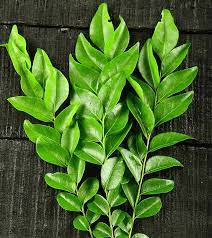BOTANICAL NAME: Murraya koenigii
FAMILY: Rutaceae
CLASSICAL CLASSIFICATION:
Aacharya Charaka : kanthya, sangyasthapana mahakashaya
COMMON NAME:
Gujarati : mitho limdo
Hindi : kadi patta
Malayalam : kariveppu
Telugu : karivepaku
Tamil : kariveppikai
English : curry leaves
PLANT IMAGE with Unique Identification Feature:

HABITAT: All over india
BOTANICAL DESCRIPTION:
It is Medium sized evergreen tree,grows 3-4 m height. Leaves – compound, leaflets are ovate –pointed, Flower – white, Fruit – berry
AYURVEDIC CHARACTERISTICS:
| RASA | GUNA | VEERYA | VIPAKA | PRABHAVA | DOSHGHNTA |
| Tikta, Kashaya, madhura | Laghu, Rooksha | Sheeta | Katu | Kaphapitta har |
AYURVEDIC ENERGETICS:
| TASTE | PROPERTY | POTENCY | POST DIGESTIVE EFFECT | EFFECT ACTION | DOSHA ACTION |
| Bitter, Astringent, Sweet | Lightness,
Drynss |
Cold | Pungent | Pacifying kapha and pitta |
MAJOR CHEMICAL CONSTITUENTS: Coumarins, murrangatin, Mexolide, phebalosin, carbazole alkaloids and flavonoids
THERAPEUTIC USES:
- Palitya – curry leaves paste with coconut oil is applied to the scalp for premature hair graying.
- Mukhpaka – paste of leaves is applied to the mouth ulcers.
- Kandu – oil prepared with curry leaves is beneficial in pruritus.
INDICATIONS:
Kandughna (treat pruritus), kusthaghna (useful in skin disorders), deepen (appetizer), vishahara (anti-poisonous), balya (bulk-promoting), keshya(good for hair)
USEFUL PART: Leaves, root
DOSAGE: Leaves powder – 3-6 gm
AYURVEDIC FORMULATION:
- Kaidaryadi Kashaya
- kalashakadi kashaya
